Selecting the best hiking shoe is the most critical decision any hiker has to make. Whether your trip is hours or days, your shoes can be one of the most essential factors in comfort, effectiveness, and protection. Thus, how do you determine the best shoes among the variety of shoes for hiking? And for you, I have created this guide so that you get the perfect hiking shoes to make every step of yours happy and bold.
Understanding Your Hiking Needs
Selecting the best hiking shoes for men and women begins with your demands or preferences. Each hike is unique; the best shoes depend on your preferred hiking.
Below are three essential questions to ask yourself before you go shopping:
- Where will you be hiking?
Do you plan on staying primarily off-piste, or does tackling rough terrain not scare you? What your shoes have to be will depend on the type of trail you will go rucking! If the trails are designed to be smoother rolling terrain, you may opt for more of an experienced shoe that is lighter because those surfaces often have minimal hazards. - How long will your hikes be?
You need trail runners for a short day hike rather than boots during a week-long trek. Right before your next short hike, you could be looking for a comfortable and light shoe or boot, while the long hikes across varied terrain require durability and support throughout miles. - How will the weather hold up?
Think about the climate and weather patterns of where you will be hiking. Will it be hot and dry, or are you in for a wet day? Breathability is potentially a more important factor when walking in the summer, but the lack of waterproofing will matter for other situations—particularly wet conditions. Knowing these things allows you to pick the right hiking shoes for your needs and be prepared no matter what is thrown at you on any given adventure.

Types of Hiking Shoes
After you discover all your traits, it is time to delve into the types of hiking shoes. They are all made for a reason and have a lot of new conditions, so selecting the right category is very important.
- Hiking Shoes:

La Sportiva Men’s Boulder X Hiking Shoes Cut lower than hiking boots, these lightweight shoes work best for day hikes on maintained trails. As mentioned, they are similar to running shoes and combine athletic stretch with overall support for day hikes or just casual hikers enjoying the lighter side of trail hiking shoes.
- Hiking Boots:
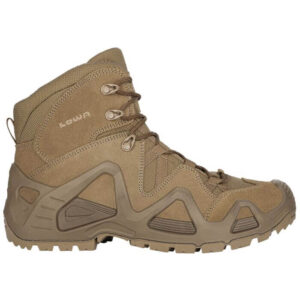
Lowa Zephyr Mid TF Hiking Boots Offering more support for the ankle, hiking boots for men and hiking boots for women are best suited to rougher terrain and longer hikes. They typically have a mid-to-high cut that supports the ankle over rough terrain. Choose these for a multi-day hike or carrying weight. They are also available in waterproof options, making them some of the best hiking shoes for variable conditions.
- Backpacking Boots:
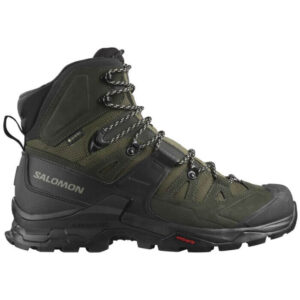
Salomon Quest 4 GORE-TEX Backpacking Boots These backpacking hiking boots are intended to work when the going gets serious. They often come with stiffer midsoles for support and endurance. The best backpacking footwear is heavy but relatively stable and offers the most protection and support for longer, rugged trail hiking. They are the best trekking shoes for any journey if you are not taking off on a multi-day backpacking adventure.
- Trail Running Shoes:
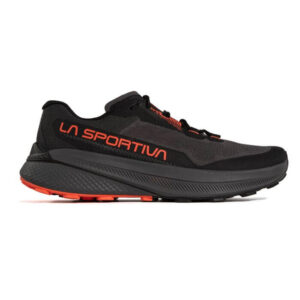
La Sportiva Prodigio Trail Running Shoes Unlike typical hiking shoes, men’s trail running shoes and women’s trail running shoes are for those who prefer further and faster. Light and flexible with moderate grip for running off-road. These might be the best hiking shoes for those more aimed at being fast and gentle, mainly if your chosen terrain is well-paved.
- Mountaineering Boots:
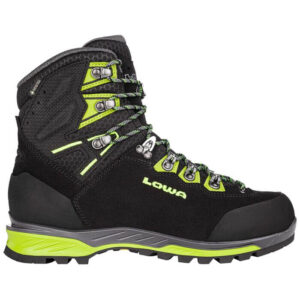
LOWA Alpine Ice GTX Mountaineering Boots If you like to hit high-altitude climbs or icy and snow-laden terrains in the winter, then ordinary rubber soles will not cut it. It is one of the most rugged and durable types you could wear hiking, giving you the best protection.
Factors to Consider When Choosing Hiking Shoes
When picking out your hiking shoes, consider the following factors to ensure you get the best fit-
- Fit and Comfort: The first thing on the list of the most essential attributes for a shoe is how it fits the person’s foot. It shouldn’t be too informal, wet, and prohibited; there must be room to tip your toes when wearing footwear.
- Material: The material used to make the shoe, be it leather or other material used in making that shoe, will define how heavy it is, how long your foot will remain fresh in that shoe, and whether the shoe will last for one year or not.
- Weight: Shoes with a higher weight, say 10 ounces, are expected to give the users enhanced support compared to those with 2. 5 ounces. These extra ounces can easily ruin your feet. It also proved that an extra weight of approximately 5 ounces can make your feet quickly sore. Specify the need for light hiking shoes for day hikes and/or easy trails.
- Waterproofing: Waterproof shoes may be essential if you walk in some areas. While Waterproof hiking shoes are designed to be worn when there is water on the path you will tread on, you are assured your feet will remain dry.
- Traction: It is possible to get better traction by increasing the outsole stickiness if this hiking is carried out on slippery or rough terrain. When selecting the shoes to wear, consider shoes with deep lugs and shoes that are not easily worn out by rubber material.
- Support and Stability: Good support on the ankles is very important as the terrain will be irregular, thus posing a significant threat to the ankles.
Therefore, hiking and backpacking boots provide the most support to the ankle part of the foot.
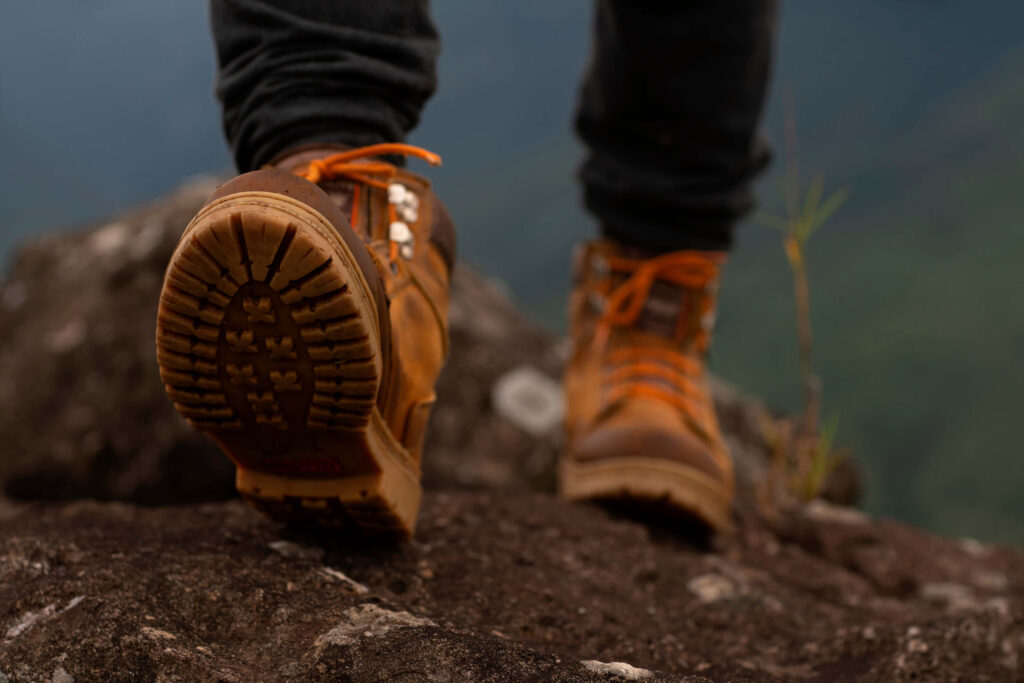
Tips for Trying on and Testing Hiking Shoes
When you try your new hiking shoes, keep the following in mind:
- Try on Shoes in the Afternoon: Your feet swell as the day passes, meaning earlier testing won’t give an accurate picture.
- Wear Hiking Socks: Bring or wear men’s hiking socks for a proper fit.
- Test the Fit: Put them on and walk around, jump, or do whatever you need to simulate hiking conditions in the store. Note any pain or discomfort.
- Space Check: Ensure there is enough room in the toe box, but the heel must not slip while you walk.
- Test your Shoes before: Once you’ve purchased men’s hiking shoes, wear them on shorter walks before heading out on a long hike.
Additional Tips
- Weight of the Shoe: Weight is of the essence in contributing to the success of the hike you are planning. Daily use of hiking shoes is enough for day hiking, while serious hiking boots are required when the terrain is more complicated.
- Brand and Reviews: Search for reviews in the market to identify good quality, long-lasting outdoor boots from well-established manufacturers. Some valuable information can be extracted from the user experiences and reviews regarding the shoe’s functionality.
- Cost and Value: The price tag of the cheapest hiking shoes may be appealing, but it is better to add some cash to get quality shoes to save you from other inconveniences such as foot fatigue or injury. Consider longevity, for it is a crucial factor, considering you often use it for hiking.
Conclusion
The selection process for a better hiking shoe depends on the hiker to a certain extent. It means knowing what shall be required to achieve in the hike, the category of shoes, and fundamental factors such as size, material, and support, among others. Whether you are out for a hiking shoe or a newcomer to the trail, spend some time and get the right shoe to complement your hiking expedition. Wear comfortable shoes to ensure they have been tried out best before the next trail is taken.
For the best hiking shoes, you can connect with us!
Frequently Asked Questions
1. What should I look for when choosing hiking shoes?
When choosing hiking shoes, you should consider the following factors- Fit & Comfort, Material, Shoe Weight, Traction, Support, and Stability.
2. What’s the difference between Hiking Shoes and Hiking Boots?
Hiking Shoes are lower cut, lighter, and more flexible, providing agility and comfort for day hikes or lighter trails. In contrast, Hiking Boots are higher cut, offer more ankle support, and are designed for rugged terrains.
3. How should hiking shoes fit?
Your hiking shoes should not be tight; instead, there should be a thumb’s space width. They should make you feel comfortably snug and supportive.